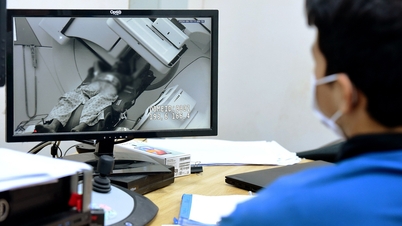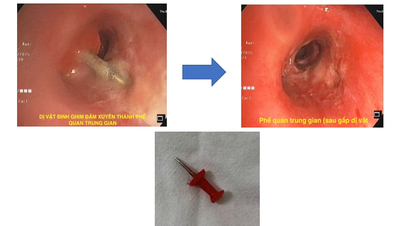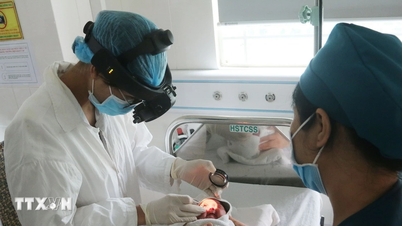Distinguish clearly between functional foods and drugs
Sharing at the online discussion "Functional foods - Understand correctly to use correctly", Associate Professor, Doctor, Pharmacist Nguyen Tuan Dung, Former Head of the Department of Clinical Pharmacy, University of Medicine and Pharmacy, Ho Chi Minh City, Professional Consultant of Long Chau Pharmacy System, said that drugs and functional foods are two completely different concepts.
Functional foods are regular foods that have been supplemented with substances that may be beneficial to health, including vitamins, minerals, amino acids, fatty acids, enzymes, yeasts, or beneficial bacteria (probiotics and prebiotics).
These products must be legally declared by the Food Safety Department ( Ministry of Health ), which means they must fully meet current standards and regulations, undergo testing, and have their impact on human health assessed by competent medical research agencies. In the case of products advertised as supporting treatment, the research and testing must be carried out at provincial hospitals or higher.
“Functional foods are not medicines and do not have the effect of treating diseases. On the product label, it is mandatory to clearly state two “no” contents. First, the mechanism of action must not be stated. Second, the line “This product is not a medicine and does not have the effect of replacing medicine” must be clearly stated,” Associate Professor Dung emphasized.

Associate Professor, Doctor of Pharmacy Nguyen Tuan Dung, Former Head of Department of Clinical Pharmacy, University of Medicine and Pharmacy, Ho Chi Minh City, Professional Consultant of Long Chau Pharmacy System and Doctor Dao Trong Thanh, Deputy Head of Department of Examination B, Friendship Hospital shared at the seminar.
Sharing the same view, Dr. Dao Trong Thanh, Deputy Head of Examination Department B, Friendship Hospital, added that, scientifically , functional foods can provide the body with vitamins, minerals, amino acids, fatty acids, probiotics, as well as necessary enzymes. However, it should be emphasized that this is not medicine.
“Their effects are only to regulate and support the body's normal growth and metabolism, but do not have any therapeutic effect. Vitamins in functional foods only act as an initiator, participating in the metabolic process, but do not have any inhibitory or specific pharmacological effects like drugs,” said Dr. Thanh.
For example, he said, in some drug mechanisms, there are types that stimulate the body's immune process, helping to enhance protective responses. Conversely, some other drugs have the effect of inhibiting inflammatory reactions, thereby helping to limit inflammatory reactions of cells, especially during the aging process or the development of cancer cells.
This shows a clear difference between functional foods and drugs. Drugs have a therapeutic effect, intervening in the pathological mechanism; while functional foods only support the body to maintain balance and healthy functioning.
However, the current dietary supplement market also exposes many risks. Associate Professor Dung likens the general situation to the saying “one bad apple spoils the barrel”, causing dietary supplements to be misunderstood and bring about many consequences.
According to him, the problem of exaggerated advertising is a worrying reality. Many places do not hesitate to use misleading words, such as "cleaning the arteries" instead of the correct medical term "reducing blood lipid disorders".
Because “fat” is just a name when it is outside the body – like on a plate of food – but when it enters the body, it exists in the form of cholesterol and triglycerides. Of which, there is the type that needs to be increased (HDL – “good cholesterol”) and the type that needs to be reduced (LDL – “bad cholesterol”).
However, due to exaggerated advertising language, such as “cleanse your veins”, “leave your skinny past behind”, or “miracle slimming pill”, many people are drawn in by unrealistic promises and believe that this is an alternative to medical treatment.
Another issue is the origin and quality of the products. Whether imported or domestically produced, all products must have documents proving their legal origin, undergo medical testing at competent authorities or provincial hospitals or higher, and when released to the market must meet the standards of the National Institute of Nutrition. However, in reality, there are still many floating products, of unknown origin, released to the market with eye-catching designs, cheap prices, but do not guarantee quality.
The underlying cause is that the profit of the functional food market is too high. Because manufacturers do not need to invest in research and clinical trials, the cost is low but the profit is high. From there, counterfeit goods easily infiltrate the market, causing a lack of control and loss of trust.
How to identify fake, poor quality functional foods



Associate Professor Dung pointed out the fact that buyers are often mistaken, but sellers are never “wrong”. Sellers know very well what they are selling - the problem is that consumers must know how to choose a reputable place to protect themselves.
First of all, choose establishments with clear origins and official licenses. A simple rule is: if they are just street vendors, displaying their goods on the roadside, then if a problem occurs, they can immediately disappear.
As for serious investment units, with addresses, brands, and operating licenses from the authorities, they will not trade their entire careers just for a bottle of medicine or a box of functional foods.
Therefore, consumers need to check if the product has a “visa” - that is, a product declaration certificate issued by the Food Safety Department (Ministry of Health ). This is the only legal sign to trust a product that is officially circulated on the market.
According to him, in reality, even medical experts find it difficult to distinguish between real and fake products with the naked eye. Counterfeit products are made very sophisticatedly, from color, flavor to packaging. Therefore, only through testing and certification from the authorities can the true quality of the product be determined.

Buyers are often mistaken, but sellers are never “wrong”. Sellers know very well what they are selling - the problem is that consumers must know how to choose a reputable place to protect themselves.
Therefore, the most important thing when buying functional foods is to see if the product has a “visa” issued by the Food Safety Department or not. That is the “passport” that ensures reliability, helping consumers avoid falling into the trap of poor quality products.
Dr. Thanh mentioned some quite clear signs.
Firstly, if a medicine or functional food is advertised loudly, exaggeratedly, appearing massively on social networks with words like "miracle drug", "cure all diseases", "replacement of treatment drugs", and is also promoted by celebrities or social media influencers, then there must be a question mark.
A truly good product does not need such a loud advertising campaign, especially in the medical field which requires clear scientific proof.
Second, if the product is sold too easily, through hand-carried channels, street vendors, personal livestreams, or widely sold like the "aphrodisiac drugs in the flea market" before, then its origin is very suspicious. It cannot be said that all drugs sold like that are fake, but products with exaggerated effects, sold without control and of unknown origin often pose a very high risk of quality and safety.
Third, people now have more access to healthcare than before. If they have mild symptoms such as fever, they can go to the doctor the same day and get tested immediately to determine the cause, such as influenza A, influenza B or dengue fever. However, the downside of this convenience is that people can easily buy poor quality drugs or functional foods.
He said that consumers need to be alert, should only use products with clear origins, licensed for circulation by the Drug Administration or the Food Safety Department (Ministry of Health), and should consult a doctor or pharmacist before using any medicine or functional food.
So, in summary:
- Real medicine does not need to be "deified".
- Safe drugs are not sold easily.
- Reliable drugs must have clear certification and origin.
Using functional foods incorrectly - "a double-edged sword"
During the treatment process at the hospital, Dr. Thanh himself encountered many cases where patients mistook functional foods for medicine, leading to arbitrarily reducing the dose or stopping treatment, causing unfortunate consequences.
A typical case is a female patient around 70 years old, who has had diabetes for many years. Her blood sugar has been controlled stably with conventional treatment drugs.


However, recently, following the advice of an acquaintance, she started using dietary supplements such as Gymnema Sylvestre and Wild Bitter Melon Tea as a substitute for medication. After only one month, her blood sugar spiked, forcing her to be hospitalized for emergency treatment.
Another case is a patient after heart valve replacement, taking the anticoagulant sintrom - a drug that must have its dose adjusted monthly by the doctor to maintain stability.
However, this patient arbitrarily used additional functional foods such as Ginkgo biloba (ginkgo extract) and garlic and ginger juice with the thought that they had the effect of lowering blood lipids. After about a month, the patient experienced bleeding gums and subcutaneous hemorrhages, and had to return to the hospital for a check-up.
“These functional foods interact with anticoagulants, increasing the effects of the drugs, leading to the risk of serious bleeding. Such cases show that, although they are called “functional foods”, if used incorrectly, especially in parallel with treatment drugs, they can cause dangerous interactions for patients,” Dr. Thanh analyzed.
He once again emphasized that functional foods cannot replace medicine, and using them without a doctor's guidance can make the disease worse, even life-threatening. When you have a disease, you need to be treated with medicine, and functional foods are only a supplement and support factor.
The role of functional foods in the trend of shifting from treatment to prevention
Dr. Thanh shared that he clearly felt that along with the development of society in terms of economy, politics and life, people's awareness and health care behavior have also changed profoundly.
If in the past, patients only went to the hospital when their illness was severe or symptoms were obvious, some even had a fever for a week or had a stomachache for months before going to the doctor, now they only need to feel tired or have unusual signs for a few days, or even a few hours to proactively go to medical facilities for examination.
This shows that the availability and convenience of the current healthcare system, along with improved socio-economic life, have helped people shift from passive treatment thinking to proactive healthcare.
“Even in the story of functional foods, we can clearly see a positive side of this change. Many people are more aware of early disease prevention or improving their health to limit the risk of disease.
If in the past the concept of functional foods almost did not exist, people only knew about calcium and vitamin A supplements for children as prescribed by health authorities, now they know how to research and choose products suitable for their physical condition and needs," said Dr. Thanh.

With functional foods, we also need to use them in stages, based on the actual needs and condition of each patient. This need is determined through examination, testing and clinical assessment, not by feeling.
This also places higher demands on quality management and official information, but on the positive side, it is a very welcome development. Because changing the habit from “waiting for illness to treat” to “early prevention” is a big step forward in public awareness.
As a medical professional, he highly appreciates this transformation, both in people's thinking and actions, because it shows that Vietnamese society is moving closer to a proactive, sustainable and modern healthcare model.
With functional foods, he recommends using them in stages, based on the actual needs and condition of each patient. This need is determined through examination, testing and clinical assessment, not by feeling.
For example, children in the bone development stage can be supplemented with calcium; pregnant women or elderly people with anemia need to supplement folic acid and vitamin B12; elderly people with osteoporosis are advised to take additional calcium and vitamin D. All of these supplements must have a clear medical basis.
However, in the elderly who are taking multiple medications, adding additional dietary supplements can cause interactions.
Whether it is a vitamin or a mineral, when introduced into the body, it must undergo absorption, metabolism and excretion through the liver, kidneys and skin. If this metabolic system is already overloaded with many drugs, adding functional foods can affect the drug's activity.
“Medicines and functional foods both have their own roles, but they must be used as prescribed, in the right dose, at the right time, and under medical supervision. Functional foods cannot replace drugs, and when combined incorrectly, they can cause more harm than good,” Dr. Thanh shared.
Source: https://dantri.com.vn/suc-khoe/hieu-dung-ve-thuc-pham-chuc-nang-de-tranh-ruoc-hoa-vi-tin-quang-cao-20251022105024745.htm


![[Photo] Da Nang: Shock forces protect people's lives and property from natural disasters](https://vphoto.vietnam.vn/thumb/1200x675/vietnam/resource/IMAGE/2025/10/22/1761145662726_ndo_tr_z7144555003331-7912dd3d47479764c3df11043a705f22-3095-jpg.webp)



![[Photo] Prime Minister Pham Minh Chinh chairs meeting on nuclear power plant construction](https://vphoto.vietnam.vn/thumb/1200x675/vietnam/resource/IMAGE/2025/10/22/1761137852450_dsc-9299-jpg.webp)





































































































Comment (0)